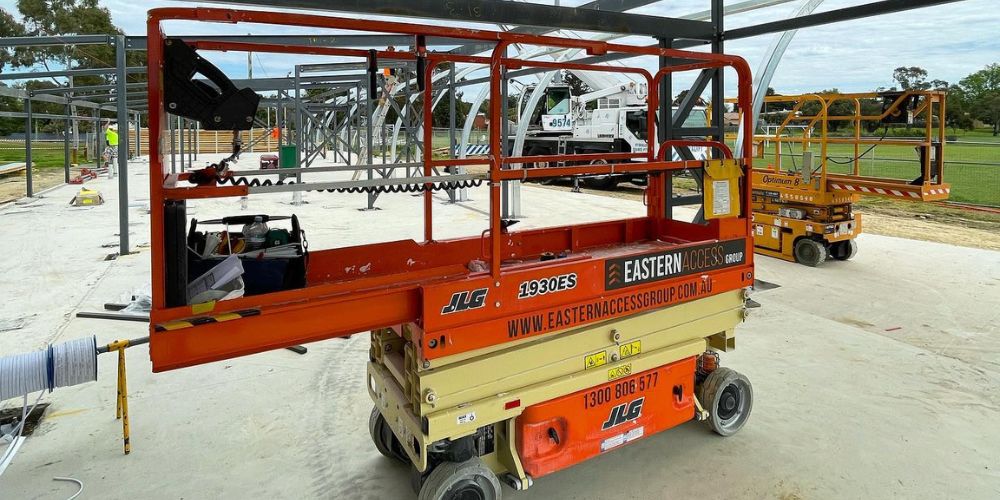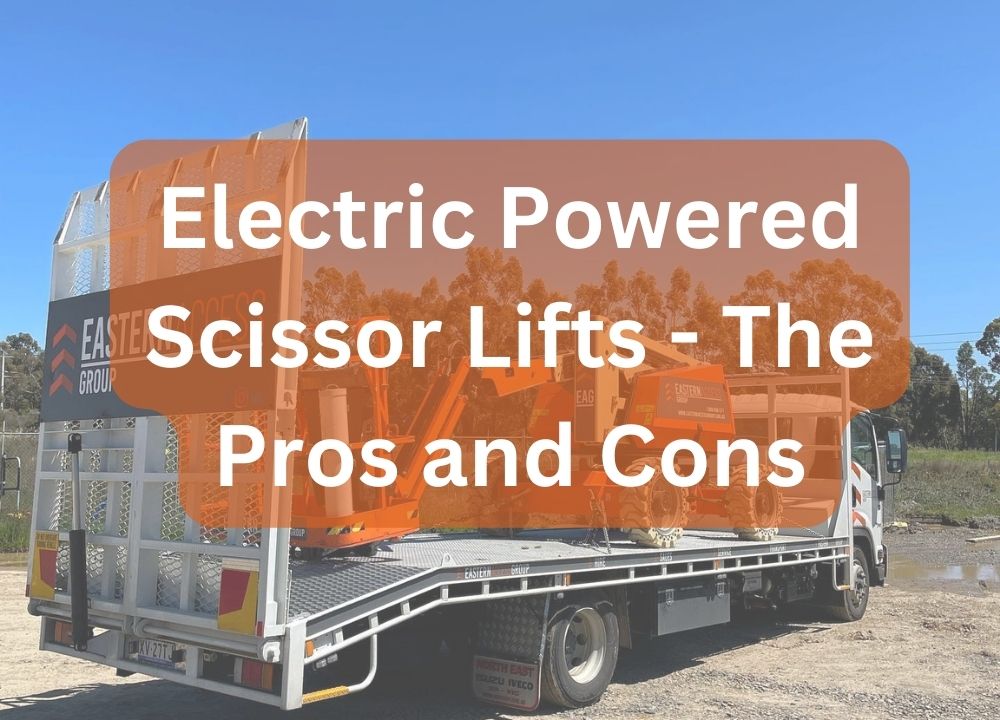Electric Powered Scissor Lifts - The Pros and Cons
Scissor lifts are mobile elevated work platform (MEWP) types extensively used in the construction and maintenance sectors to give safe and efficient access to high areas.
As worries about air pollution and noise levels grow, more firms are turning to electric scissor lifts as an alternative to traditional diesel-powered ones.
Electric scissor lifts are gaining popularity due to their advantages over diesel-powered lifts, such as decreased noise levels, zero emissions, and cheaper running expenses.
Let us explore more some of the advantageous features of electric-powered scissor lift and why they are becoming one of EWP equipment favorite among lift hire.
Table of Contents

What are Electric Powered Scissor Lifts?
Electric-powered scissor lifts are a type of mobile elevated work platform (MEWP) that uses electric motors rather than diesel engines. They are intended to give employees a safe and efficient means of gaining access to high regions in various indoor and outdoor environments. Electric scissor lifts work by raising and lowering a platform on a scissor-like mechanism, utilising crisscrossing supports. The electric motor uses a hydraulic pump that raises and lowers the platform, and a platform operator controls the lift.
Electric-powered scissor lifts are becoming increasingly popular in various sectors due to their significant benefits over diesel-powered lifts. They are quieter, emit no pollutants, and cost less to operate and maintain. They are also often more user-friendly, with smoother acceleration and deceleration and more straightforward controls.
Electric vs Diesel Powered Scissor Lifts – Which is Better?
The decision between electric and diesel scissor lifts is influenced by several factors, including the job’s unique requirements, the work environment, and the available budget. Both elevators have distinct advantages and disadvantages, which must be carefully considered before selection.
Electric scissor lifts are better suited for interior use or noise-sensitive areas. They are quieter, emit no pollutants, and offer cheaper running expenses because they do not require gasoline or oil changes. Electric lifts are also often easier to use, with fewer controls and smoother acceleration and deceleration. However, because of the battery life, they have a limited runtime, which can lead to downtime and lost productivity. They may only be ideal for some outdoor work conditions.
Scissor lifts fueled by diesel, on the other hand, are better suited for outdoor use and rugged terrain. They have a higher maximum weight capacity and extended travel range than electric lifts, making them ideal for more big construction sites. They are, however, often louder and emit hazardous pollutants, which can be an issue in indoor or noise-sensitive areas. In addition, they require more maintenance and have more extraordinary fuel expenses than electric-powered lifts.
The decision between electric and diesel scissor lifts is determined by the job’s unique requirements and the work environment. An electric-powered lift may be preferable for interior or noise-sensitive areas. In contrast, a diesel-powered lift may be preferable for outdoor or complex terrain tasks. Finally, both types of lifts are valuable instruments for providing safe and efficient access to high areas. They may be an advantage in various sectors.

Electric Powered Scissor Lifts Pros and Cons
Pros
Quieter Operations
Because of their quieter operation, electric scissor lifts are ideal for indoor or noise-sensitive situations. They emit zero pollutants and are ecologically friendly, making them a healthier option for employees’ health. Electric lifts offer cheaper operational expenses since they are more energy-efficient and do not require fuel or oil changes. They are also simpler to operate, with smoother acceleration and deceleration and quicker lift and descent times.
Zero emissions
Electric scissor lifts are eco-friendly since they emit no pollutants. Diesel-powered lifts emit toxic pollutants that can endanger employees’ health and contribute to air pollution. Electric-powered elevators provide a safe and healthful work environment, especially in confined environments with inadequate ventilation. Electric elevators with zero emissions help enterprises comply with environmental standards and decrease their environmental effect.
Lower operational costs
Because they do not require fuel or oil changes, electric scissor lifts offer cheaper operating expenses than diesel-powered ones. They are powered by rechargeable batteries that may be reused and need minimal maintenance. Electric motors consume less energy than diesel engines, allowing electric lifts to run on a single charge for extended periods, resulting in higher productivity and less downtime.
Ease of Use
Because of their simpler control systems, smoother acceleration and deceleration, and shorter lift and descent periods, electric scissor lifts are easier to use than diesel-powered ones. Electric lifts have quick torque and responsiveness, whereas diesel engines take time to develop power and speed. Electric lifts may also be started and stopped at the touch of a button, minimising the time and training necessary for operators.
CONS
Runtime is limited
One of the most known drawbacks of electric scissor lifts is their short duration. Batteries power electric lifts with a limited charge and must be recharged after a set time. As a result, electric lifts may not be appropriate for longer-term projects or job locations that require constant use.
Outdoor usage is restricted
Another disadvantage of electric-powered scissor lifts is their inability to be used outside. Electric lifts are often less potent than diesel-powered lifts. They may need help in challenging outdoor circumstances like rugged terrain or extreme weather. Furthermore, the batteries may drain faster in cooler weather, further limiting their outside usability.
Higher initial expenses
Electric scissor lifts have higher initial costs than diesel-powered ones. This is owing to the higher cost of batteries, which are usually more expensive than diesel engines. The more significant upfront expenses make it more difficult for some firms to justify investing in electric-powered lifts, mainly if they are only used occasionally.
Limited range
Electric scissor lifts have a restricted range as compared to diesel-powered ones. They can only work within the range of their battery charge, which limits their mobility and use on more important job sites. On the other hand, diesel-powered lifts can be refuelled on the job site and have a more excellent range, making them more adaptable for some purposes.
Frequently Asked Questions
Electric scissor lifts are often more expensive than gas or diesel-powered lifts. On the other hand, electric lifts have reduced running expenses over time due to decreased maintenance and fuel expenditures. Furthermore, electric lifts are more ecologically friendly than gas or diesel-powered lifts and cause less noise pollution. Finally, the buyer’s requirements and use determine the cost-effectiveness of electric scissor lifts.
Connect the lift to a charging station using a power connection to recharge the batteries on an electric scissor lift. The charging time varies according to the battery capacity and the charging technology utilised.
Regular battery, control system, and hydraulic components checkups are required to maintain an electric-powered scissor lift. The lift should also be kept clean and clear of debris. The operator should adhere to all safety requirements and maintenance protocols.
The lifting capability of an electric scissor lift varies based on its size and power. In general, diesel-powered lifts have a more excellent lifting capability than electric-powered lifts. On the other hand, electric-powered lifts can still carry substantial loads and are frequently preferred due to their lower emissions and quieter operation.
Conclusion
Electric scissor lifts provide various benefits over diesel-powered scissor lifts, including reduced emissions, quieter operation, cheaper operating costs, and simplicity of use. However, they have several restrictions, including limited runtime, outside usage, more significant upfront expenditures, and restricted range.
When deciding between electric and diesel scissor lifts, examine the individual demands of the business, such as the type of job, work environment, and budget. Electric scissor lifts may be more suited to interior or noise-sensitive situations. In contrast, diesel-powered scissor lifts may better suit severe outdoor conditions or longer-duration projects. The initial cost of electric-powered lifts should be considered, as should the potential cost savings from decreased operational expenses during the equipment’s lifetime.

